- Other Fluke companies:
- Fluke
- Fluke Biomedical
- Fluke Networks
- Fluke Process Instruments
Dry-Block Calibrators vs. Temperature Baths: Choosing the Right One for You
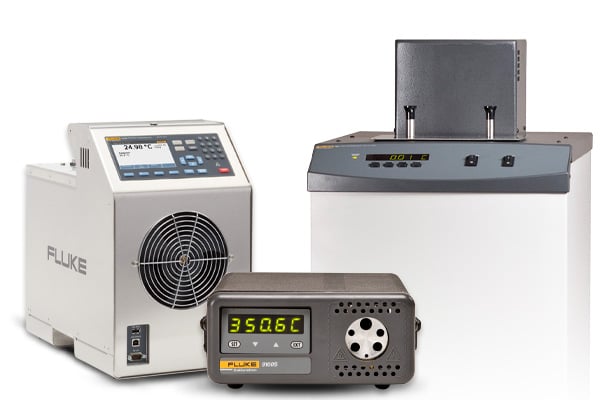
Temperature sensors are typically calibrated by placing them in a stable temperature source and comparing their output to the output of a calibrated reference. Two common sources are dry-block calibrators and temperature baths, but which is right for you? Let’s start our dry-block calibrator vs. temperature bath analysis by defining each.
Dry-block calibrators
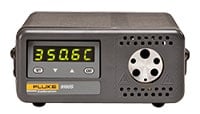
Dry-block (dry-well) calibrators use pre-drilled metal inserts for inserting the temperature sensor that is being calibrated. These dry-block calibrators have a removable metal insert with pre-drilled holes where sensors are inserted for measurement. The dry-block insert provides a stable temperature source which can be adjusted to different test points. It relies on good thermal contact between the metal insert and the temperature sensor so the inserts typically have different hole sizes. Usually the display is calibrated so it can be used with or without a reference thermometer. These calibrators offer good stability, an insert that can typically calibrate one to three sensors at a time, and lightweight, compact enclosure for easy transport to the field.
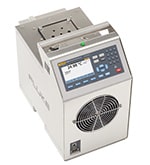
Temperature baths
A temperature calibration bath is a uniform enclosure with a stirred fluid that can be adjusted to various temperature test points. By using a stirred fluid (e.g. water, silicone oil, methanol, ethanol), baths provide excellent thermal contact, uniformity, and stability for temperature sensor calibration. They offer a large working volume and flexibility for calibrating temperature sensors of different shapes and sizes. Usually only the smaller, portable baths have calibrated displays. The larger baths require a reference thermometer for calibration traceability. Temperature baths are available in different tank sizes, including Micro-Baths (0.75 L), portable (2.5 L), compact (9.2 L), deep-well compact (15.9 L), and standard baths (27 to 42 L).
Five variables to consider when deciding between a dry-block calibrator and a temperature bath
Here are five things you'll want to consider when deciding whether a temperature bath or dry-block calibrator is best for you and your application:
1. Temperature range
Fluke Calibration offers several dry-block calibrators including handheld models, Field Metrology Wells, and Metrology Wells that cover a temperature range of –95 °C to 700 °C. Refer to theFluke Calibration Dry-Block Product Comparisonfor more information on dry-block calibrators available for the temperature range of your application.
Fluke provides a variety of temperature baths that cover a range of –80 °C to 550 °C. While each model has an advertised temperature range, often no single bath fluid works well over the entire range. For example, a Fluke Calibration 7341 Deep-Well Compact Bath has a range from –45 °C to 150 °C. Ethanol is a good fluid for this bath below 0 °C, but at temperatures above 0 °C another fluid such as silicone oil would be required. As a result, calibration labs must choose between changing bath fluids or using multiple baths to cover the full temperature range of their application. Refer to the Buying the Right Temperature Calibration Bath for Your Laboratory application note for more information on bath temperature ranges and fluids.
2. Sensor size
When calibrating sensors, proper immersion depth in the temperature source is important. The minimum immersion depth the sensor needs to be inserted into the dry-block or bath for accurate measurement is determined by the diameter of the sensor and the length of its internal sensing element. A general rule is the minimum sensor immersion depth needs to be 15 times the sensor diameter plus the length of the internal sensing element.
Dry-block calibrators work well for calibrating straight, small diameter sensors such as RTD and thermistor probes and sheathed thermocouples. While liquid-in-glass thermometers (LIGs) may fit in a dry-well insert, they can easily get stuck or break during the calibration process. Therefore, temperature baths are recommended for calibrating liquid-in-glass thermometers.
Temperature baths are also best for calibrating large, long, or odd-shaped sensors. These include bimetal dial thermometers, digital thermometers, RTDs with transmitter heads, thermocouples with long sleeves, and sanitary sensors with flanges. They are also needed for calibrating PRTs with lower uncertainties due to the superior performance that temperature baths can provide.

The following table summarizes well and tank depths for select Fluke Calibration dry-block calibrators and temperature baths:
Dry-block calibrator well depths
| Dry-block calibrator | Well depth |
| 9100S Handheld Dry-Well | 3.5 in (89 mm) |
| 9102S Handheld Dry-Well | 4.0 in (102 mm) |
| 9009 Industrial Dual-Block Thermometer Calibrator | 4.0 in (102 mm) |
| 9103, 9140 Dry Block Calibrators | 4.9 in (124 mm) |
| 9142, 9143, 9144 Field Metrology Wells | 5.9 in (150 mm) |
| 9170 Metrology Well | 6.3 in (160 mm) |
| 9171, 9172, 9173 Metrology Wells | 8.0 in (203 mm) |
Temperature bath tank depths
| Temperature bath | Tank depth |
| 6102, 7102, 7103 Micro-Baths | 5.5 in (140 mm) |
| 6109A/7109A Portable Baths | 6.1 in (154 mm) |
| 6330/7320/7340 Compact Baths | 9.3 in (234 mm) |
| 7380 Compact Bath | 7.0 in (178 mm) |
| 6331/7321/7341/7381 Deep-Well Compact Baths | 18.0 in, (457 mm) |
| 7080/7011/7040/6050H Standard Baths | 12.0 in (305 mm) |
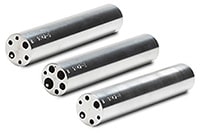
3. Batch size
There are a variety of available inserts for dry-block calibrators, with different size holes and numbers of holes. The maximum batch size of RTD and thermistor probes that can be calibrated with a dry-block is typically one to three. The limiting factor is the number of probes that can fit in the insert simultaneously without the probe handles touching each other above the dry-well. For sheathed thermocouples, it’s common that anywhere from one to three dozen can be calibrated at a time in a dry-block calibrator. Dry-block calibrators are more sensitive to sensor loading errors which are caused by heat travelling in and out of the dry-block through the inserted temperature sensors which create temperature gradient errors.
Due to their tank open size and depth, temperature baths provide the best flexibility for calibrating a large batch of sensors including big, long, or odd-sized ones. Refer to the Buying the Right Temperature Calibration Bath for Your Laboratory application note for a summary of tank opening and depths for Fluke Calibration baths.Baths are also less sensitive to sensor loading errors because they typically have more depth than dry-block calibrators and the stirred-fluid and lid help isolate the sensor from ambient conditions. Plus, the sensors can be spread out over a larger measurement area while maintaining excellent temperature uniformity. Fluke Calibration has designed and built custom test and calibration baths with racks and other features allowing for specialized calibration of hundreds of sensors at a time.
4. Work location
Dry-block calibrators are ideal for sensor calibration in the factory or field . Since they are portable and lightweight, they can be easily carried on a cart or in a vehicle by one person to a job site. Because they use no fluids, there’s no spillage concerns when transporting dry blocks.
Due to their size and use of fluids, compact, deep-well compact, and standard temperature baths work best in a laboratory setting where sensors are brought in for calibration rather than transporting the calibration equipment to a work location. However, 6109A/7109A Portable Baths and 6102/7102/7103 Micro-Baths are designed for transport to the field and have secure lids to minimize fluid spills during transport.
5. Accuracy needed
Stability, uniformity, and display accuracy are important specifications to consider when selecting a temperature source. Stability is the ability of the source to maintain a constant temperature over time. Uniformity is the ability of the source to maintain a constant temperature throughout its working area. In general, temperature baths have better stability and uniformity than dry-block calibrators since they use stirred fluid that creates a better calibration environment than a metal block, especially when the probe doesn’t fit into the metal block properly.
Usually, the portable temperature sources have a calibrated display while baths designed to stay in the laboratory do not. A calibrated display means the portable source has an integrated temperature reference whose accuracy may be good enough for field calibration work. The display accuracy includes long-term instrument drift, non-uniformity, and stability of the dry block. There are two options to improve dry-block accuracy if needed by using an external reference PRT (platinum resistance thermometer):
Dry-block improved accuracy option 1: dry-block calibrator with external reference PRT
Some dry-block models offer a process control option that includes a reference thermometer input for measuring an external reference PRT. See the914X Field Metrology Wellsas an example. The external PRT measurement is shown on the dry-block display along with the temperature of the internal control sensor. Since the external reference PRT is more accurate than the dry block’s internal control sensor, the overall measurement accuracy is improved.
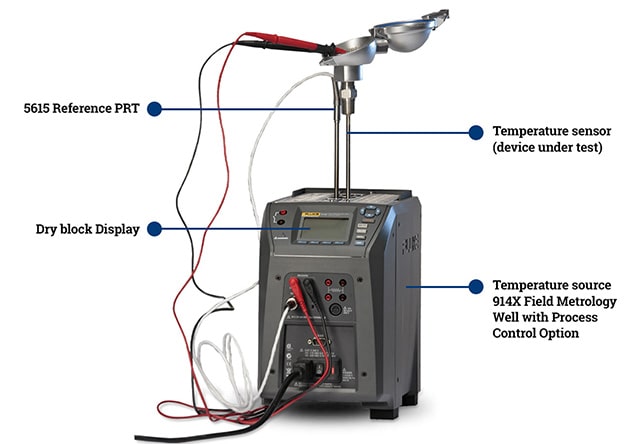
Dry-block improved accuracy option 2: dry-block calibrator with thermometer readout
If the dry-block calibrator has no process control option, another alternative is to use an external reference PRT coupled with an external thermometer readout to improve dry-block accuracy. For example, a 5615 Reference PRT is inserted into a 914X Field Metrology Well without the process control option. Next, the PRT is connected to the 1523 Thermometer which reads the PRT temperature. The 914X shows the internal control temperature measurement on its display.
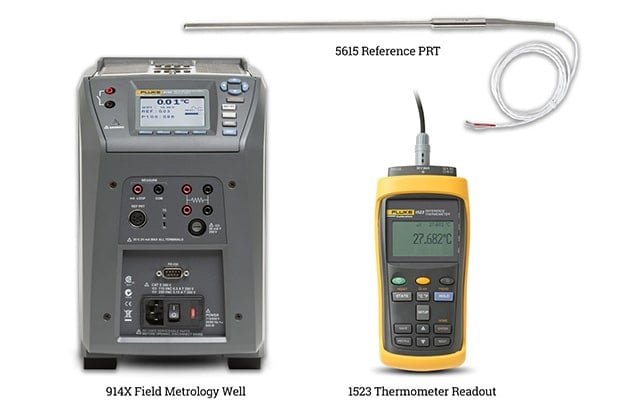
The price for both options is about the same. The dry-block with process control option is more convenient for field work since it combines the temperature source and thermometer readout into a single unit. But the dry-block with external thermometer readout option provides the flexibility of a separate, portable readout for field and lab use. One benefit of this configuration is that the dry block can be used as an uncalibrated temperature source since calibration traceability comes from the external reference thermometer and readout. Refer to theFluke Calibration Dry-Block Product Comparisonfor guidance in choosing the right dry-block based on type of sensors you’re calibrating, temperature range, and accuracy needed.
Calibration baths have a display for reading the bath fluid temperature, but typically an external reference thermometer and readouts used to establish traceability and for recording data gathered during sensor calibration. Refer to the Industrial Temperature Readout and Probe Selection Guide for guidance in selecting the right reference thermometer and readout combination with the combined accuracy needed for sensor calibration with a temperature bath.
The 1586A Super-DAQ Precision Temperature Scanner is able to control most Fluke Calibration temperature sources and with a built-in calibration automation feature it can control the temperature source, measure and record data on the reference thermometer and up to 40 DUT channels at multiple temperature points.
Summary
In summary, general guidelines for selecting a dry-block calibrator or temperature bath are:
- Identify the dry-block calibrators and temperature baths (with corresponding fluids) that will cover the temperature range of your application.
- Assess your temperature sensor workload and immersion depth needed. Temperature baths offer the most flexibility for calibrating the widest range of sensor shapes and sizes, but dry-block calibrators work great if your workload is straight probes and sheathed thermocouples.
- Determine your sensor calibration throughput needs. Temperature baths can typically calibrate the largest batch of sensors at one time.
- Evaluate whether your sensor calibration is typically done in a lab or in the field. Dry-block calibrators, Micro-Baths, and Portable Baths are easiest to transport and designed for field use.
- Determine your accuracy required for temperature sensor calibration. Temperature baths provide the best accuracy, but dry-block calibrator accuracy is adequate for many applications.
If you would like personalized help selecting a temperature bath or dry-block calibrator for your application, speak with one of our calibration equipment experts.
Keep learning
Selecting a dry-well (dry-block) temperature calibrator
Introduction to dry block calibrators
How to choose a calibration bath
Don’t get fooled: what to look for when buying an isothermal bath
Recommended products
Industrial calibrators(including dry-blocks / dry-wells)
Get help
Need help choosing a product? Speak with a calibration equipment expert
- Home
- Products
- New Products
- Electrical Calibration
- RF Calibration
- Data Acquisition and Test Equipment
- Temperature Calibration
- Humidity Calibration
- Pressure Calibration
- Flow Calibration
- Process Calibration Tools
- Calibration Software
- Service and Support
- All Calibration Instruments
- Purchase Info
- News
- Training and Events
- Literature and Education
- Service and Support
- About Us


